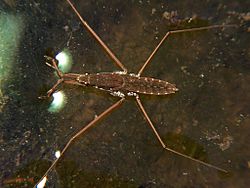Water strider facts for kids
The water strider (also called the pond skater) is a special type of insect. It belongs to a group known as true bugs, which are part of the family Gerridae. These amazing creatures are famous for their ability to glide and run across the surface of ponds and slow-moving streams. They hardly ever go underwater. Water striders have a unique body that helps them stay dry and float. There are about 500 different kinds, or species, of water striders known around the world. Some people even call them the "Jesus bug" because they seem to walk on water!
Quick facts for kids Gerridae |
|
|---|---|
 |
|
| Adult Water Strider Gerris remigis | |
| Scientific classification | |
| Kingdom: | |
| Phylum: | |
| Class: | |
| Order: | |
| Suborder: | |
| Family: |
Gerridae
|
Contents
How Water Striders Walk on Water
Water striders have an incredible superpower: they can walk on water without sinking! This is possible because of two main things: surface tension and their special legs.
Using Surface Tension
Think of the surface of water like a thin, stretchy skin. This "skin" is called surface tension. It's caused by water molecules pulling on each other. Water striders are very light, and their weight is spread out over their long legs. This means they don't push down hard enough to break the water's surface tension. It's like a tiny person standing on a trampoline without falling through.
Special Water-Repellent Hairs
The legs and underside of a water strider's body are covered with tiny, water-repellent hairs. These hairs are super small, even smaller than a human hair. They are also covered in a waxy substance. This makes them hydrophobic, which means they "hate" water. When the water strider touches the water, these hairs trap tiny air bubbles. This trapped air acts like a cushion, helping the insect float and stay dry. It's similar to how a waterproof jacket keeps you dry in the rain.
What Water Striders Eat
Water striders are predators, meaning they hunt and eat other small creatures. They are very good at sensing vibrations on the water's surface.
Hunting on the Water
When another insect, like a fly or a mosquito, falls onto the water, it creates tiny ripples. Water striders can feel these ripples with their legs. They quickly skate over to the struggling insect. They then grab their prey with their front legs.
Their Diet
Water striders mostly eat insects that have fallen into the water. This can include flies, mosquitoes, and even small spiders. They use a special mouthpart called a proboscis to suck out the fluids from their prey. They are important in keeping insect populations balanced in their habitats.
Where Water Striders Live
Water striders prefer calm, still, or slow-moving water. You can often find them in many different watery places.
Favorite Habitats
They love ponds, quiet parts of streams, and slow-moving rivers. They also live in marshes and ditches. They need water that is not too fast so they can easily glide and hunt. They often stay near the edges of the water where there might be plants. These plants offer places to hide and lay eggs.
Staying Safe
While water striders spend most of their lives on the water's surface, they can sometimes fly. They use their wings to move to new ponds if their current home dries up or becomes too crowded. This ability helps them find new places to live and find food.
Life Cycle of a Water Strider
Like many insects, water striders go through different stages as they grow. This process is called incomplete metamorphosis.
Eggs
The female water strider lays her eggs on plants just below the water's surface. The eggs are usually small and sticky. They are often laid in rows or small clusters.
Nymphs
When the eggs hatch, tiny baby water striders emerge. These young ones are called nymphs. They look like smaller versions of the adult water striders, but they don't have wings yet. Nymphs grow by shedding their outer skin, a process called molting. They molt several times, getting bigger with each molt.
Adults
After several molts, the nymphs become adult water striders. At this stage, they have fully developed wings (though some species might not have wings). They are now ready to reproduce and start the cycle all over again. The entire life cycle, from egg to adult, can take a few weeks to a couple of months, depending on the species and temperature.
Images for kids
-
A group of water striders devouring a honey bee
See also
 In Spanish: Guérridos para niños
In Spanish: Guérridos para niños




